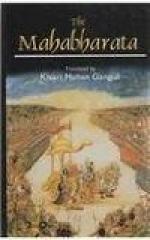122. I do not think that Telang is correct in his version of this verse. What is said here seems to be this. The body is, as it were the wheel of Time; the body is the ocean of delusion; the body is the creator, destroyer and reawakener of the universe. Through the body creatures act, and hence creation, destruction, and re-creation are due to the body. This accords with what is said elsewhere regarding the body.
123. It would be wrong to take satah as implying ‘the good,’ the finite verses in every text being singular.
124. The correct reading seems to be atmana as the last word of the first line, and not atman.
125. What is said here is that the quality of passion predominates in these.
126. Nyagrodha is the Ficus Bengalensis, Linn. Jamvu is Eugenia Jambolana, Lamk. Pippala is Ficus religiosa, Linn. Salmali is Bombax Malabaricum. Sinsapa is Dalbergia Sissoo, Roxb. Meshasringa is Asclepia geminata, Roxb. Kichaka is a variety of mountain bamboo. Here however it evidently implies the Nimba or Melia Azadirachta, Linn.
127. Nilakantha is for taking the second line as consisting of two propositions. It would be better to take satinam as referring to strinam, and vasumatyah, as an adjective of Apsarasah.
128. The sense seems to be that good men never allow others to know what their acts are. They are strangers to ostentation.
129. The sense seems to be that the knowledge of one’s own identity and of things as discriminated from one another is presided over by Prakriti. If the question is asked whence is the knowledge—’I am so,’ and that ‘this is so,’ the answer is that it comes from Prakriti or Nature.
130. As explained by Nilakantha, the word Savitri is used here to imply all forms of worship observed by Brahmanas, etc, and the Mlecchas as well. This turning back to explain a word used before is said to be an instance of “looking back like the lion”.
131. Telang, I think, renders this verse wrongly. In the first line it is said that Brahman is superior to the Prajapatis. In the second it is pointed out that Vishnu is superior to Brahman.
132. It is difficult to understand which part of the wheel is intended to be expressedly ‘bandhanam’ or the bond; I take it for the spokes. Pariskandha is Samuha or the materials that together compose an object. Here it may be taken for the nave or centre. Home is called the circumference, because, as the circumference limits the wheel, even so home (wife and children) limits the affections and acts of life.
133. The words Kalachakram pravartate have been rendered in the first verse of this lesson. In verse 9, the words asaktaprabhavapavyam are explained by Nilakantha differently. Manas-krantam, I take, is equivalent to ‘be bounded by the mind,’ I do not know whence Telang gets ’never fatigued’ as the substitute of this word.
134. Implying that he should go to the house of his preceptor, study and serve there, and after completing his course, return for leading a life of domesticity.




